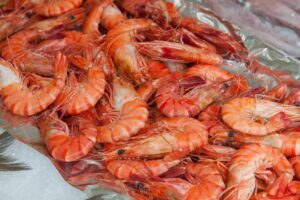Spotlighting Seasonal Seafood in NC
go.ncsu.edu/readext?954910
en Español / em Português
El inglés es el idioma de control de esta página. En la medida en que haya algún conflicto entre la traducción al inglés y la traducción, el inglés prevalece.
Al hacer clic en el enlace de traducción se activa un servicio de traducción gratuito para convertir la página al español. Al igual que con cualquier traducción por Internet, la conversión no es sensible al contexto y puede que no traduzca el texto en su significado original. NC State Extension no garantiza la exactitud del texto traducido. Por favor, tenga en cuenta que algunas aplicaciones y/o servicios pueden no funcionar como se espera cuando se traducen.
Português
Inglês é o idioma de controle desta página. Na medida que haja algum conflito entre o texto original em Inglês e a tradução, o Inglês prevalece.
Ao clicar no link de tradução, um serviço gratuito de tradução será ativado para converter a página para o Português. Como em qualquer tradução pela internet, a conversão não é sensivel ao contexto e pode não ocorrer a tradução para o significado orginal. O serviço de Extensão da Carolina do Norte (NC State Extension) não garante a exatidão do texto traduzido. Por favor, observe que algumas funções ou serviços podem não funcionar como esperado após a tradução.
English
English is the controlling language of this page. To the extent there is any conflict between the English text and the translation, English controls.
Clicking on the translation link activates a free translation service to convert the page to Spanish. As with any Internet translation, the conversion is not context-sensitive and may not translate the text to its original meaning. NC State Extension does not guarantee the accuracy of the translated text. Please note that some applications and/or services may not function as expected when translated.
Collapse ▲There is nothing like relaxing in the ocean water to cool off during our hot, humid North Carolina summers! If you cannot get to the coast, eating seafood can be the next best thing. Did you know that North Carolina has 12,331 miles of coastal shorelines? Our state’s estuarine system is also the second largest in the country! Throughout the year, fishermen harvest a bounty of marine life off the vast North Carolina coastline, catching various species of finfish, shellfish, and crustaceans that we all love to eat. Not only is seafood tasty, it is also an excellent source of protein and healthy fats like omega-3 fatty acids, which are essential for our diet and are associated with various health benefits like lower risk of heart disease, obesity, and some cancers. Today we will highlight the seafood industry in our state, touching on the seasonality of seafood, the parts of the food system pertaining to fisheries, and discuss safe preparation and resources to help you enjoy seafood at home this summer and all times of the year.
that we all love to eat. Not only is seafood tasty, it is also an excellent source of protein and healthy fats like omega-3 fatty acids, which are essential for our diet and are associated with various health benefits like lower risk of heart disease, obesity, and some cancers. Today we will highlight the seafood industry in our state, touching on the seasonality of seafood, the parts of the food system pertaining to fisheries, and discuss safe preparation and resources to help you enjoy seafood at home this summer and all times of the year.
The Seasons of Seafood on the NC Coast
North Carolina has over 70 different marine species that fishermen can catch to sell across the state and nation; however, not all species are available throughout the year. Did you know that, like produce, seafood availability is also seasonal? Fish, crustaceans, and molluscs (ex. oysters, clams, etc.) are impacted by water temperatures and currents, and their availability along the northern coast (from Currituck to Beaufort) will differ from the southern coast (Pamlico to Brunswick). The North Carolina Sea Grant program, which provides research and educational support for the NC seafood industry and consumers alike, has developed seasonal availability charts which illustrate when different seafood will be available from fishermen throughout the year. In August, species like blue crab, oysters, and shrimp are available along the whole coast, but tuna and tilefish are more plentiful along the northern coast while clams, grouper, and triggerfish are more available along the southern coast.
In addition to wild-caught operations, North Carolina fisheries also include aquaculture, which involves farming marine species under controlled conditions in ponds, lakes, oceans, rivers, and tanks. Some common species farmed in NC include finfish like tilapia, catfish, striped bass, and trout, crustaceans like crabs and crayfish, and molluscs such as clams and oysters. Aquaculture is a growing industry nationwide to keep up with increasing consumer demand for seafood year-round, and it is common to see a large portion of the seafood available at grocery stores sourced from aquaculture operations. North Carolina is currently second in the US for commercial trout production and is a large aquaculture producer of many other marine species.
The Seafood Supply Chain
Like agriculture, the seafood supply chain includes fishermen and consumers and all the steps in between. Many fishermen operate their own small businesses and harvest fish until they reach their quota per trip. They then offload their catch at fish houses, and these facilities often perform minimal processing, like fileting fish, removing shrimp heads, and picking crab meat. Wholesale customers as well as restaurants and seafood markets can buy directly from fish houses, and these businesses in turn market and distribute the seafood. Some fishermen and fish houses sell directly to consumers through roadside stands or community supported agriculture programs, but these become increasingly harder to find the further you are from the coast.
Food Safety and Resources for Preparing Seafood
Seafood, like other foods, needs to be stored and handled appropriately to minimize risk of foodborne illness from microorganisms like bacteria and parasites. After purchasing seafood, keep it frozen, iced, or refrigerated at or below 40°F until ready to use. When cooking, ensure finfish reaches an internal temperature of 145°F, which is when the flesh is opaque and flakes apart easily with a fork. For shellfish, cook until opaque; for oysters and clams, until the shells open. Keep cooked and raw seafood separate, including utensils and cutting boards used for each. For fish consumed raw or undercooked, such as in sushi or ceviche, use fish that was previously frozen to help control for parasites. Raw or undercooked seafood is not recommended for those with a weakened immune system or underlying health conditions, pregnant women, the elderly, and children. Mercury can be a concern for seafood consumption, though for most the benefits outweigh the risks. For women planning to become pregnant, currently pregnant, nursing mothers and young children, the U.S. Food and Drug Administration recommends consuming fish lower in mercury and excluding those known to accumulate higher amounts of mercury, such as shark, king mackerel, and swordfish. For inspiration on how to prepare the seasonal seafood available, North Carolina Sea Grant has also developed the Mariner’s Menu, a web-based resource loaded with recipes and tips for cooking seafood to get you started.
For more information on North Carolina’s seafood industry and local seafood availability, please contact the N.C. Cooperative Extension at the Lee County Center office and ask for Meredith Favre, our Local Foods Coordinator, for more information.




